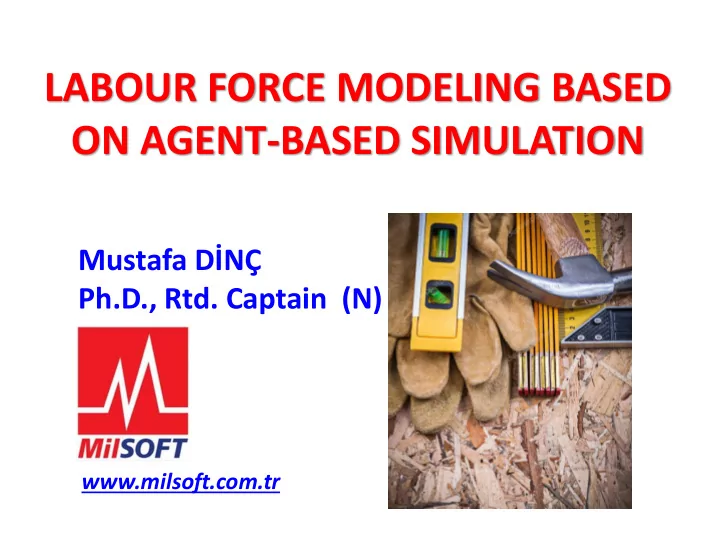

LABOUR FORCE MODELING BASED ON AGENT-BASED SIMULATION Mustafa DİNÇ Ph.D., Rtd. Captain (N) www.milsoft.com.tr
Outline • Project Goal • System Design • Modeling Approaches • Agent-Based Simulation • Simulation Tool • Results • Conclusions 2
Project Goal * Main objective is to simulate a production system and labor force modeling based on human factors (human behaviors, morale, motivation, experience, (un)expected brakes) using Anylogic simulation tool. 3
Project Goal * Then – to make an efficiency analysis of the system, – increasing the number of material output, – explore the main effects of Human factors on performance and work efficiency 4
Anylogic – A Simulation Tool http://www.anylogic.com/ 5
What is Anylogic? * is a simulation software tool * runs in multi-platform * 2D/3D animation and visualization * Java functions * Anylogic supports: Agent-based simulation, System dynamics, Discrete event simulation techniques as a software program. 6
System 3D Design Cafe & Rest Rooms Smoking Area Working Area Mess Hall Workers Depot Temporary Storage 7
Modeling Approaches 1- Discrete Event Simulation 2- Agent-based Simulation 8
Discrete Event Simulation * Identifying factor: State behavior * DES models the operation of a system as a discrete sequence of events in time . * That is, time is broken up into small time slices and the system state is updated according to the set of activities happening in the time slice. 9
Discrete Event Simulation * Countable occurrences – discrete * Focuses on system changes over time – dynamic * can both have deterministic and probabilistic variables. * Events occur according to a schedule. 10
Discrete Event Simulation 11
Agent Based Simulation * In ABS, active entities, known as agents, must be identified and their behavior defined. * They may be people, households, vehicles, equipment, products, or companies, whatever is relevant to the system. 12
Agent Definition “ Agents ” are autonomous, computational entities that can be viewed as perceiving their environment through sensors and acting upon their environment through effectors. 13
Agent – an example percepts sensors We will build agents that act agent successfully on environment their environment. effectors actions 14
Main Features of An Agent * Action — able to modify their environment and pro-active; * Communication — signals, messages, or interactions – collaboration, coordination, negotiation, and competition; * Control/Autonomy — autonomous; from each agent being a separate process (or thread) to one single process. 15
Main Features of An Agent * Adaptability — learning with experience, adapt and modify its behaviors, their environment, evolution; * Resources — where withal to do things; * Partial Knowledge — point of view; each agent can have its own set of rules and beliefs; * Capability — behavior , skills, intelligence, perceiving (sensor), mobility; * Feedback — persistence, reproduction. 16
Agent Based Simulation 17
Verification & Validation (V&V) * Focuses on the correctness of the developed computer program or model. “Building the model right ” – Debugging and testing the simulation software. * Focuses on determining whether a simulation model is an accurate representation of the system. “Building the right model ” – Comparisons of simulation results with collected data from the real system ( 5 days observation) 18
Statistics Working Times of one of 1 st Level Experienced Worker in minute 19
Statistics Working Times of all workers in minute 20
Statistics Active Working Active Working Time Percentage Time Percentage Workers Before noon Afternoon 1st Worker 34.4% 28.0% 2nd Worker 35.56% 34.33% 3rd Worker 31.9% 34.2% 1st Worker 35.3% 29.8% 2nd Worker 39.7% 33.5% 3rd Worker 38% 30.3% 1st Worker 38.5% 34.2% 2nd Worker 37.3% 42.8% 3rd Worker 40.0% 34.4% 21
Results Without Human Factors: Labor Force Efficiency: 1.Level Workers = ~ 11 products / person (hr) 2. Level Workers = ~ 8 products / person (hr) 3.Level Workers = ~ 5 products / person (hr) 22
Results Without Human Factors: Labor Force Efficiency: 1.Level Workers = ~ 8 products / person (hr) 2. Level Workers = ~ 5 products / person (hr) 3.Level Workers = ~ 3 products / person (hr) 23
Conclusion * Realistic Labor force modeling based on human factors * Agent Based Simulation * Analysis & Decision Making 24
Questions & Comments
Recommend
More recommend